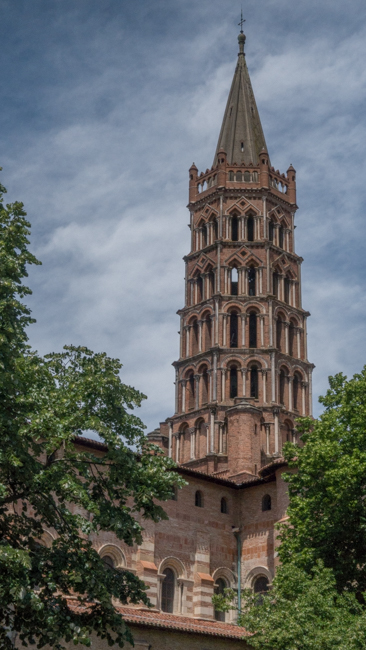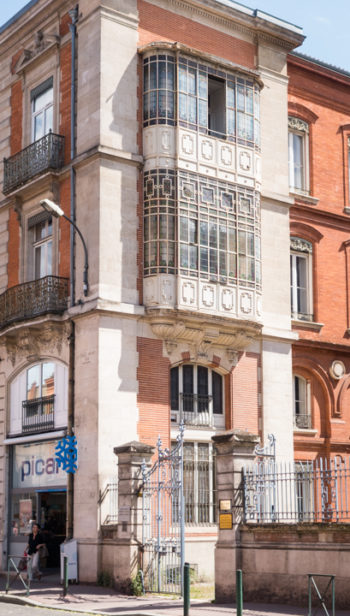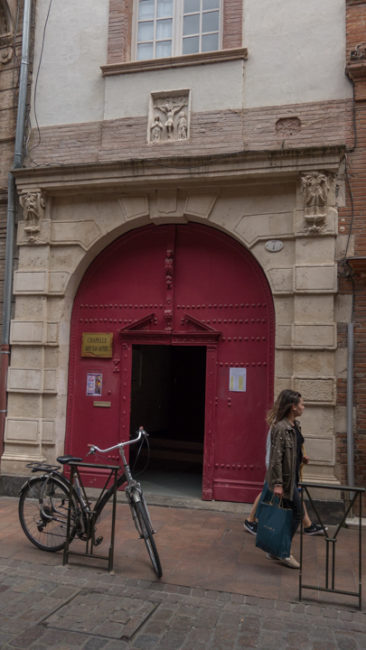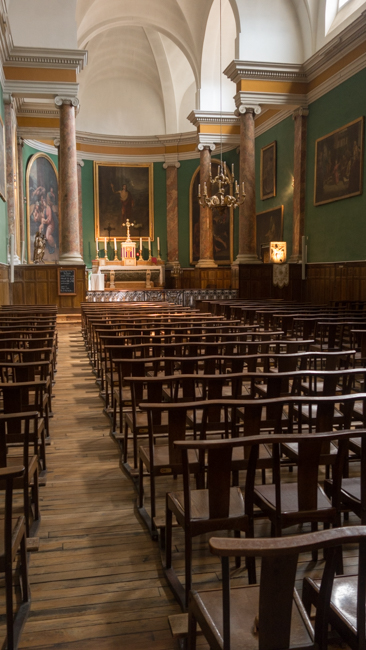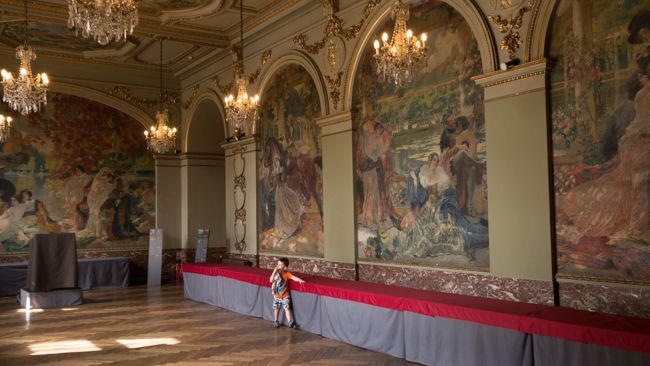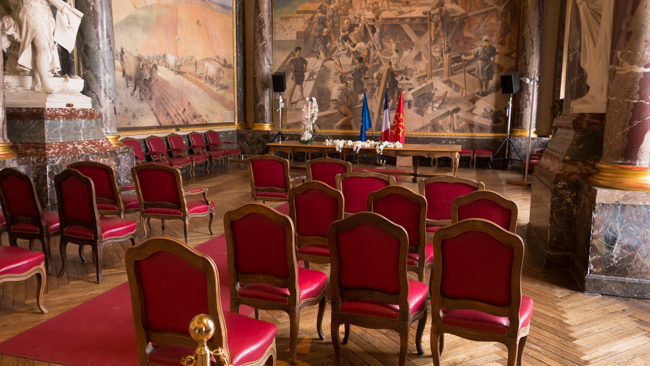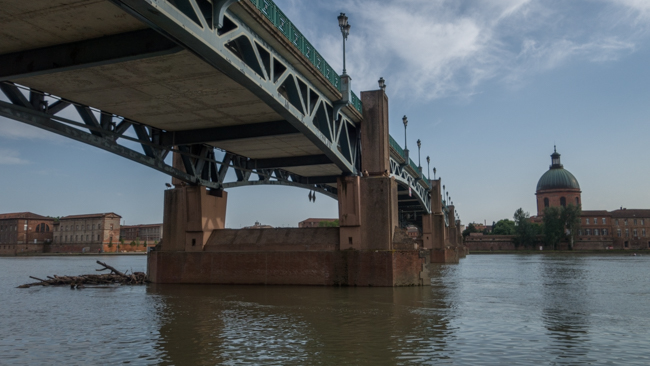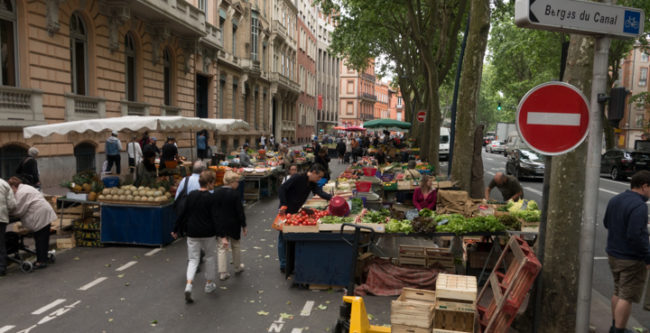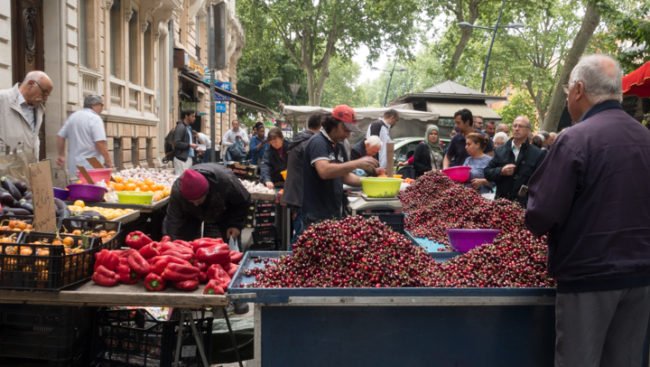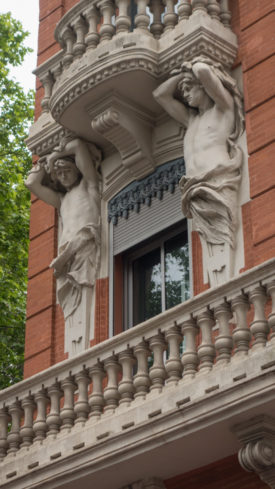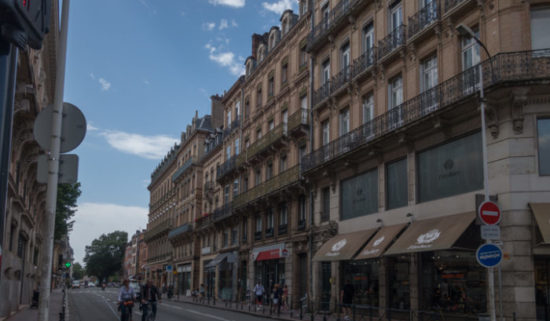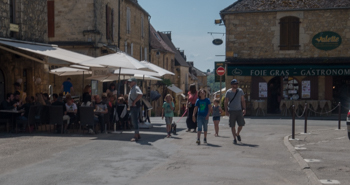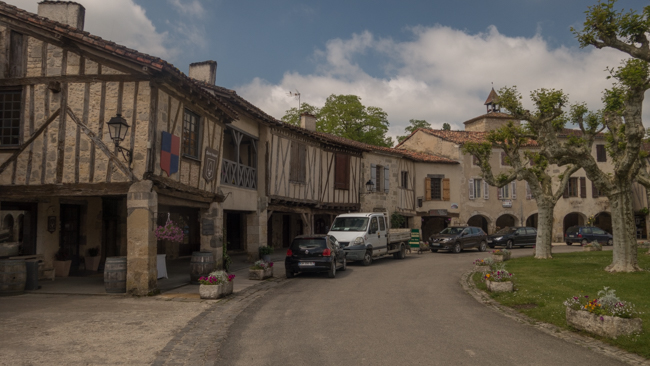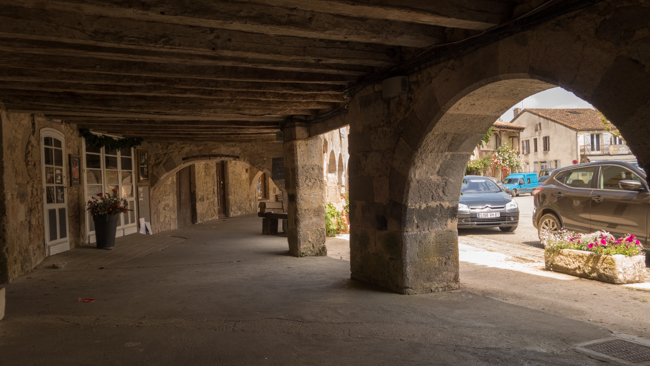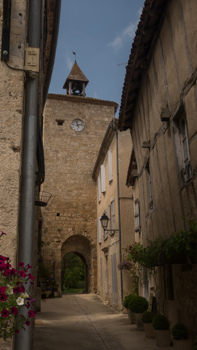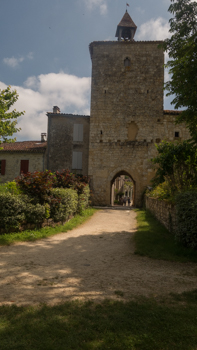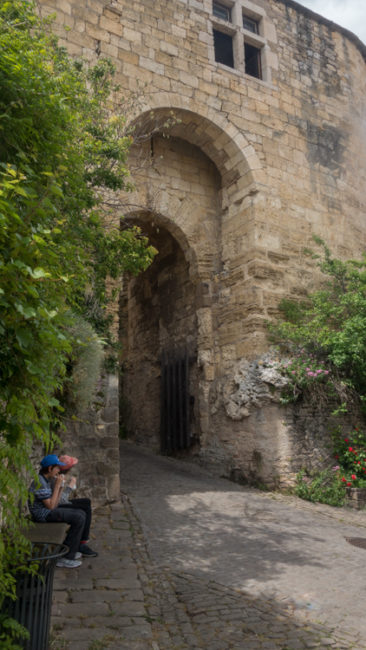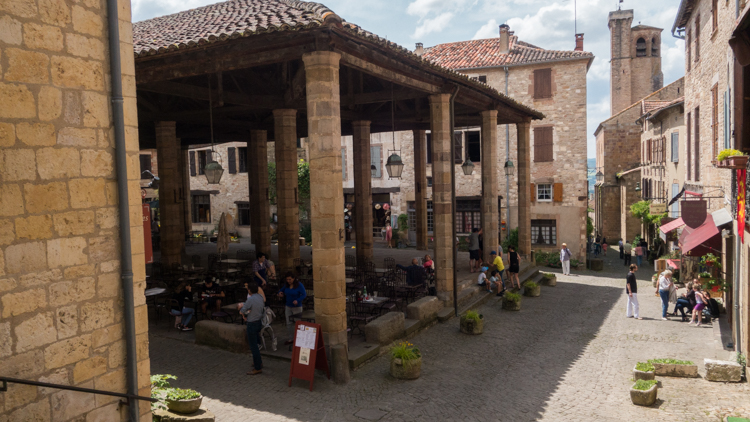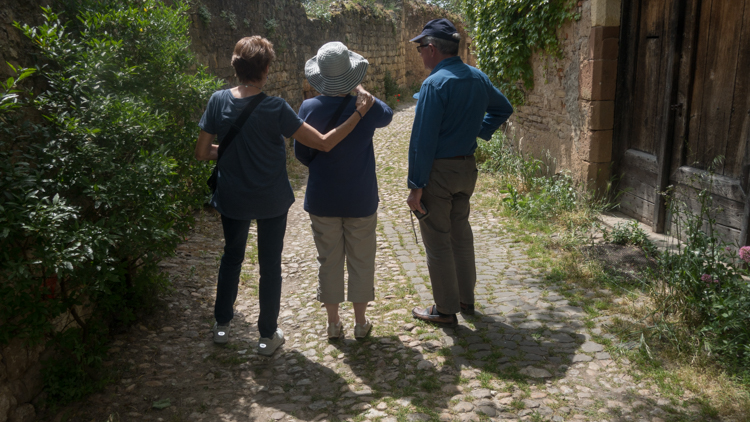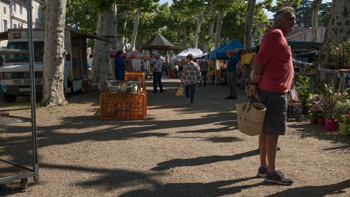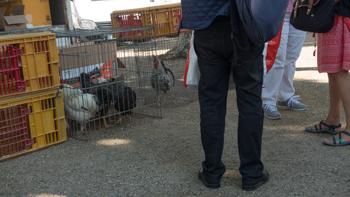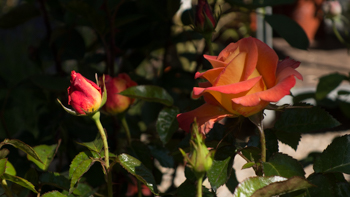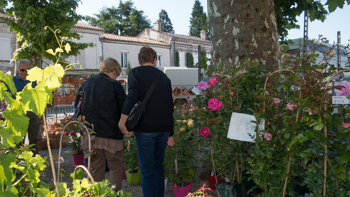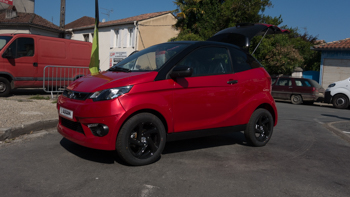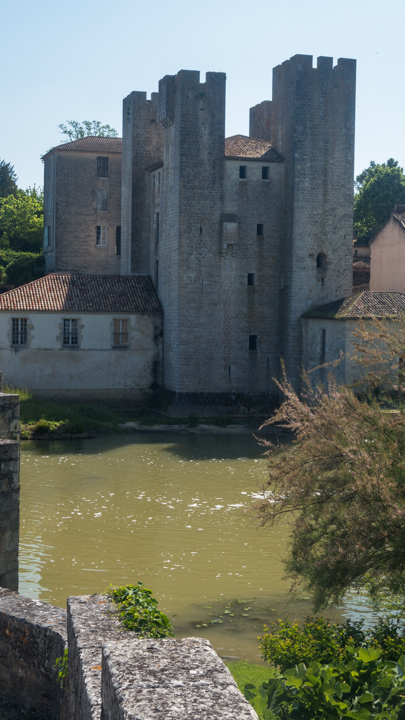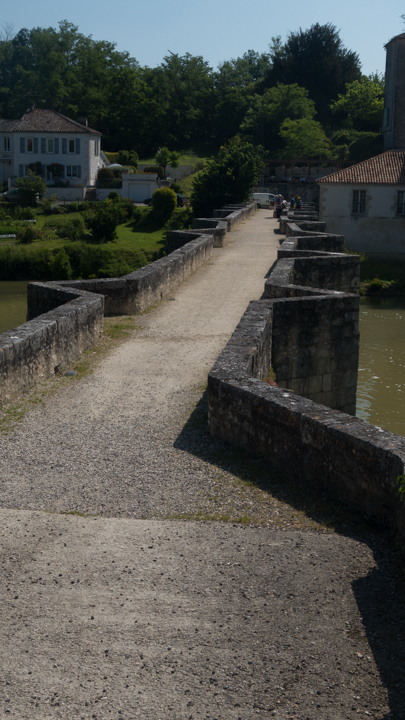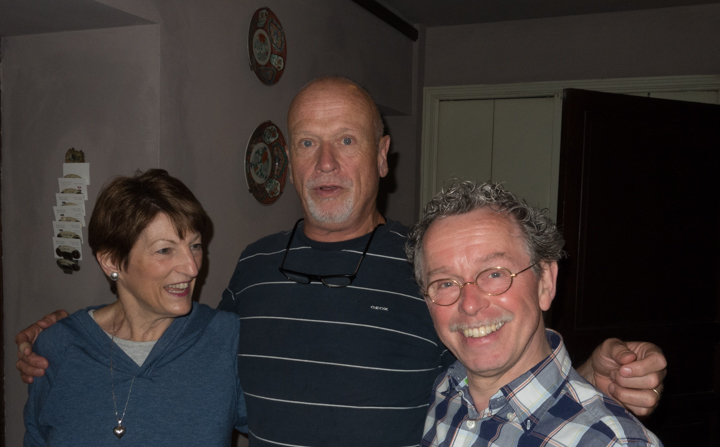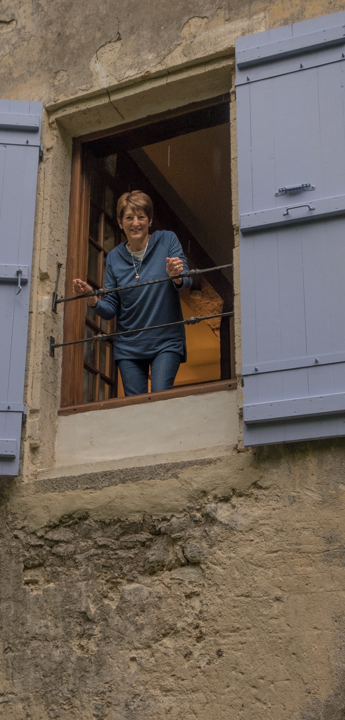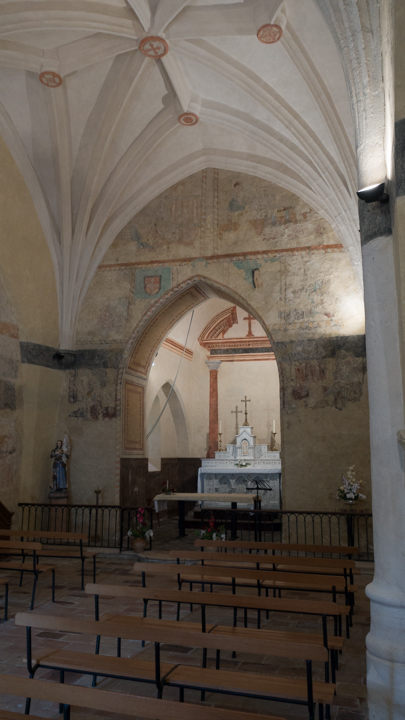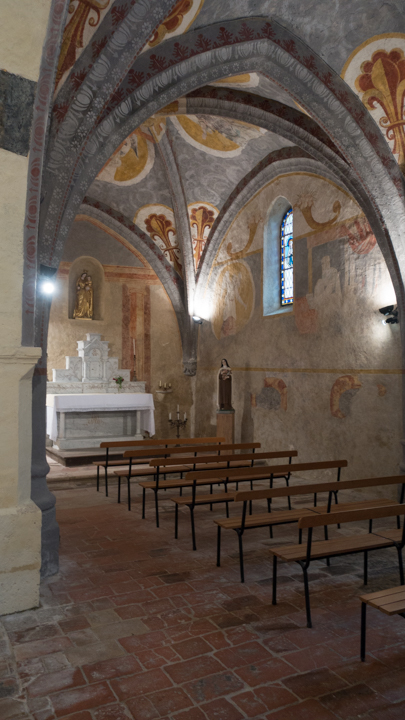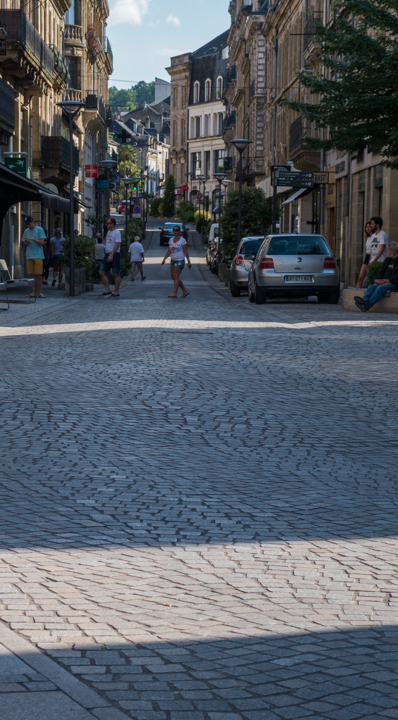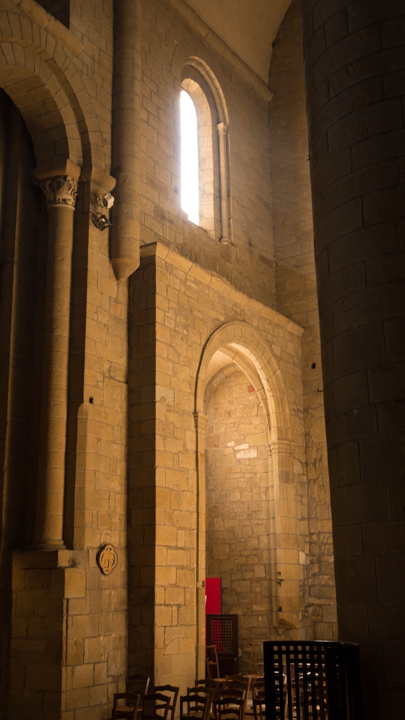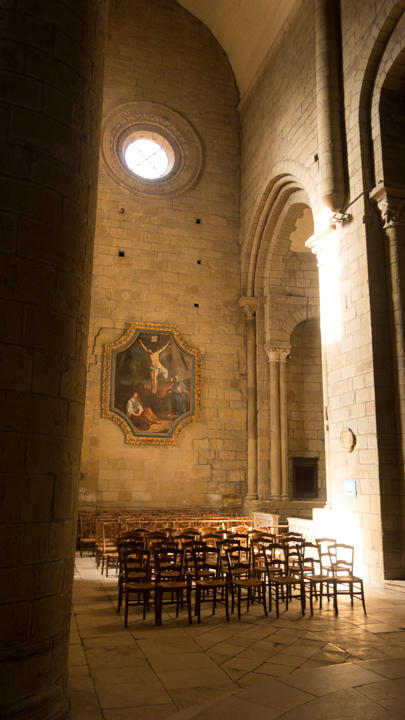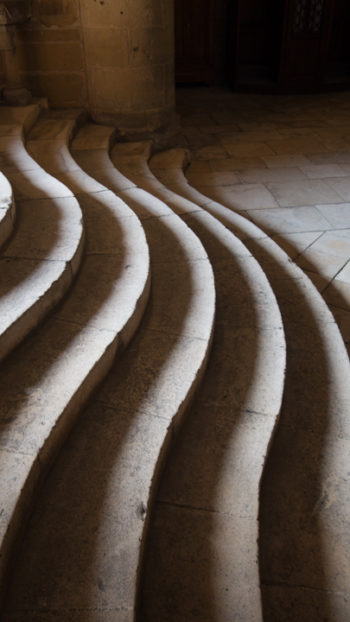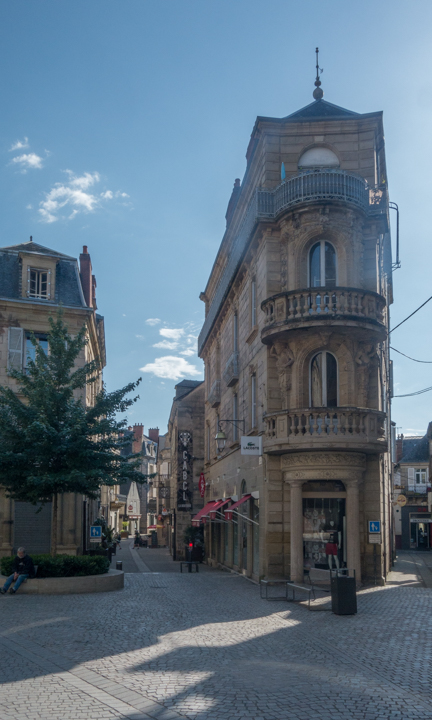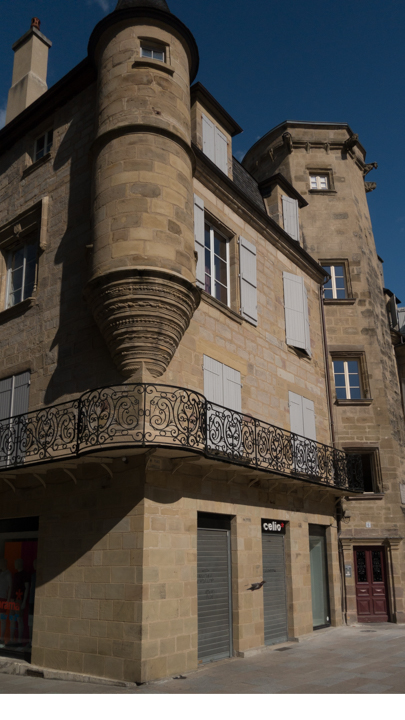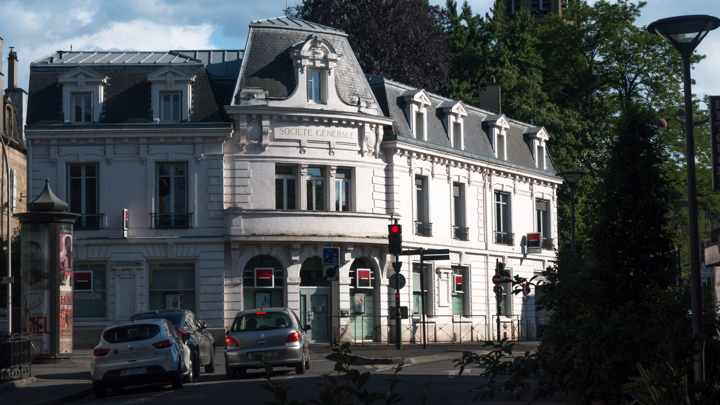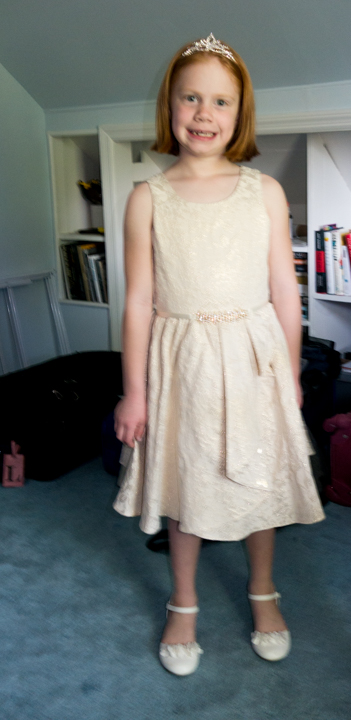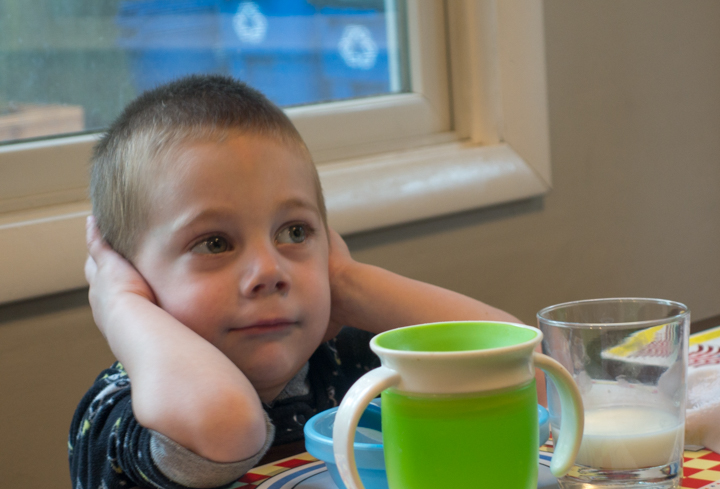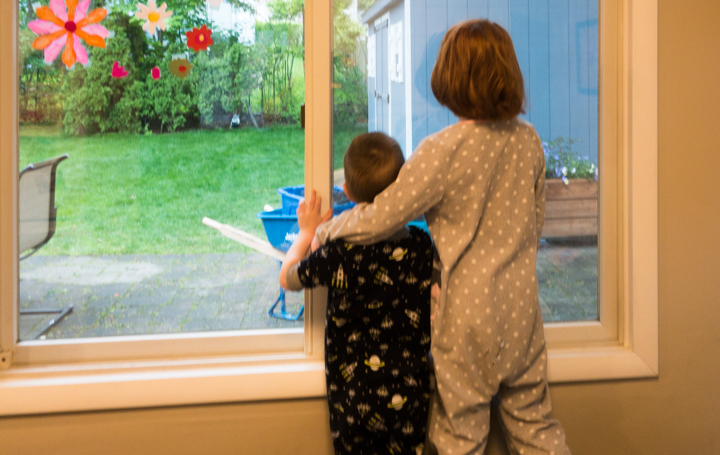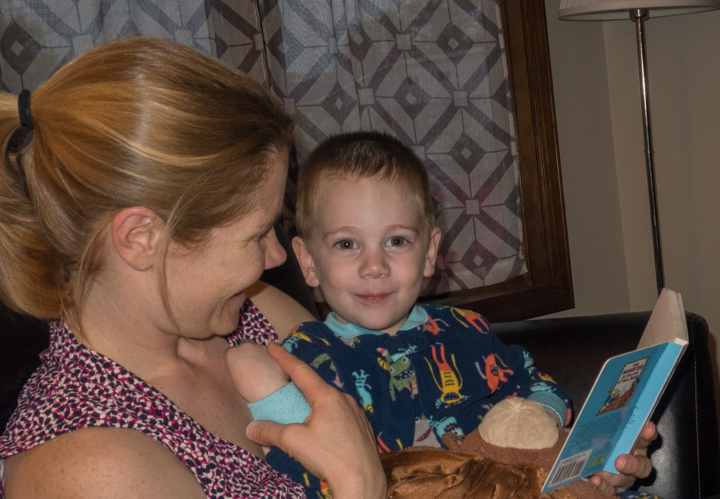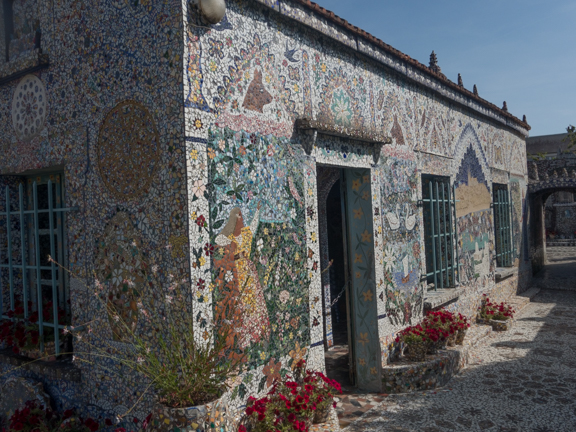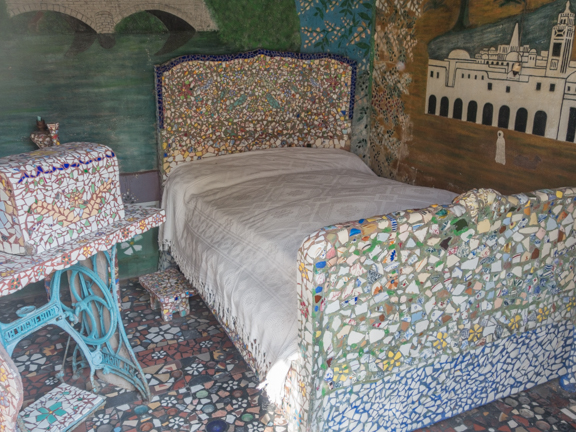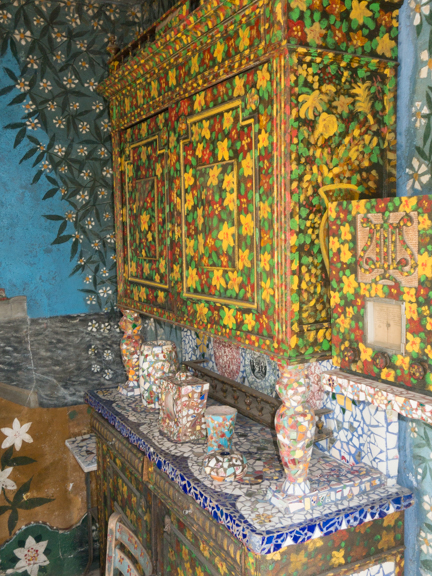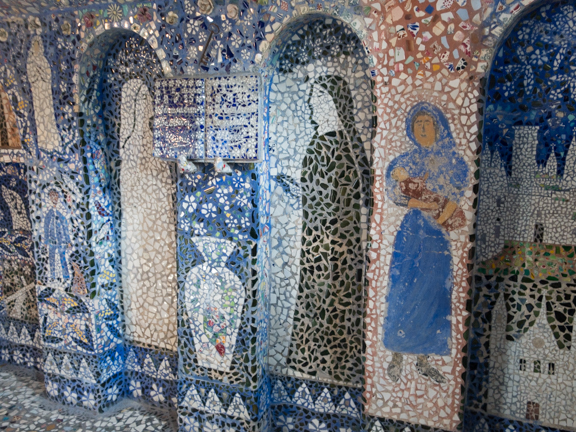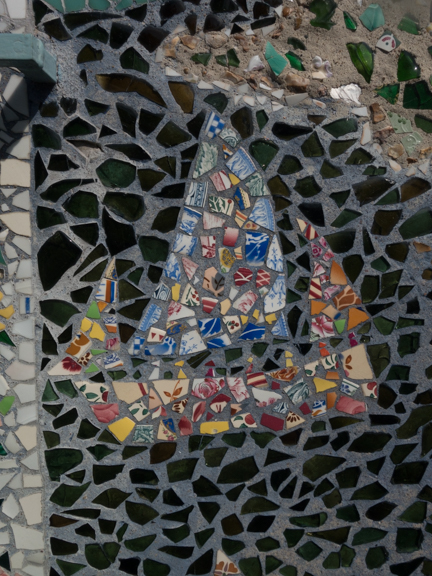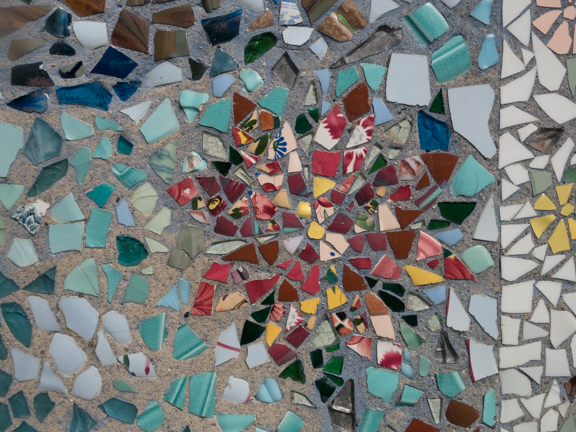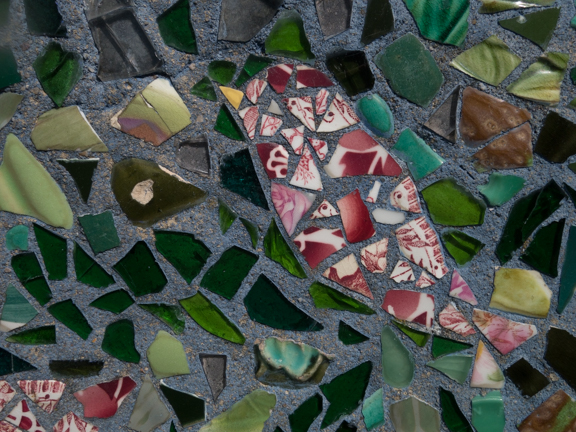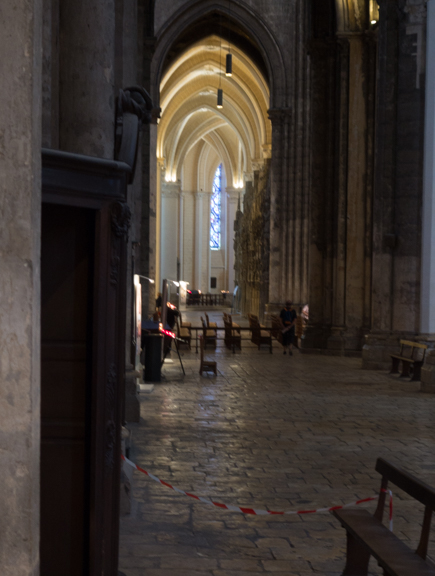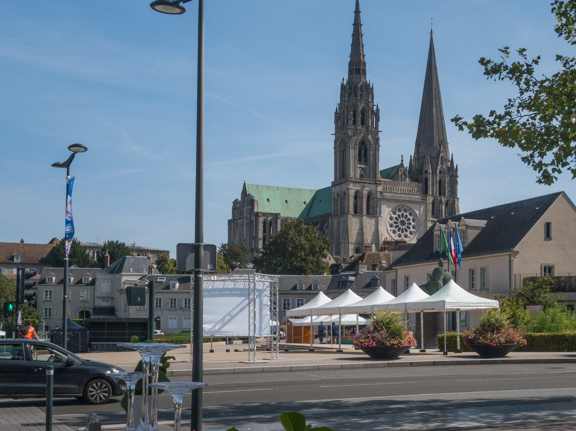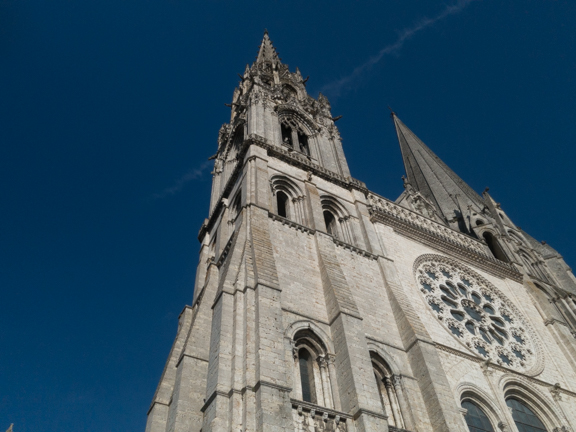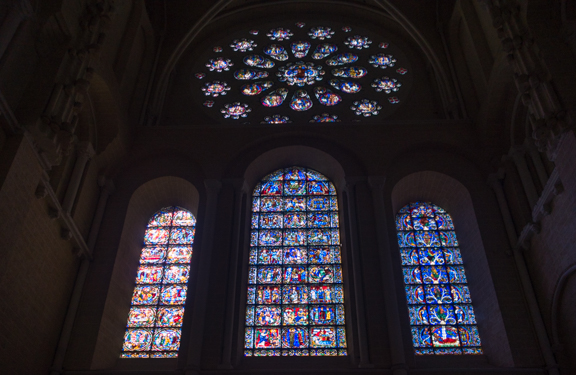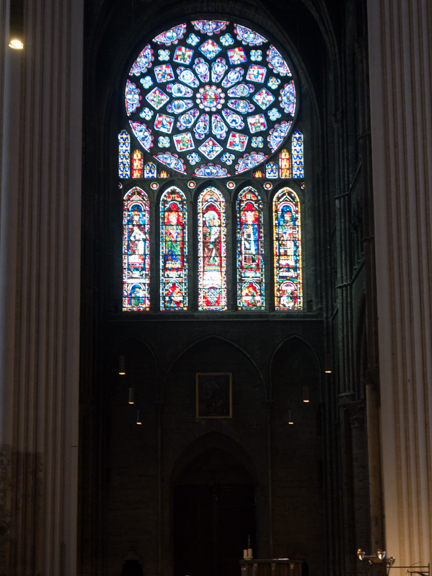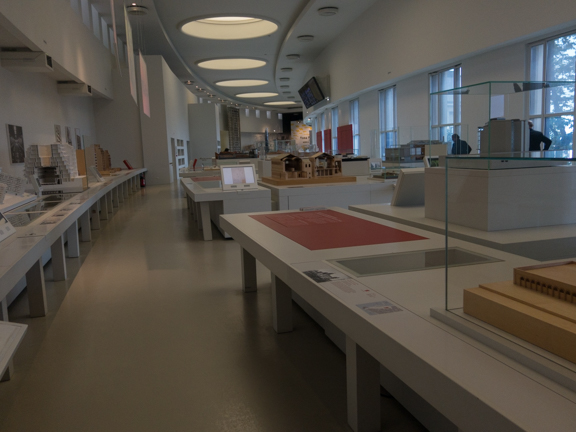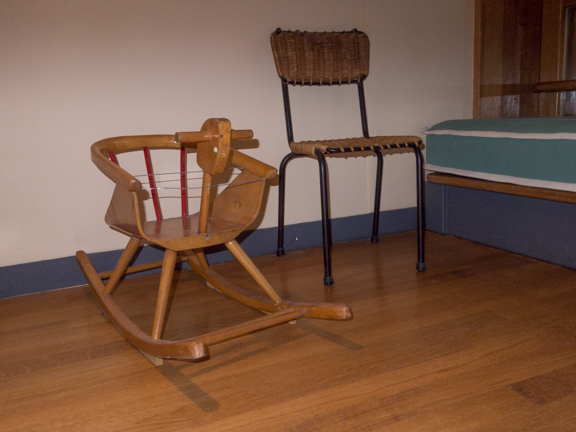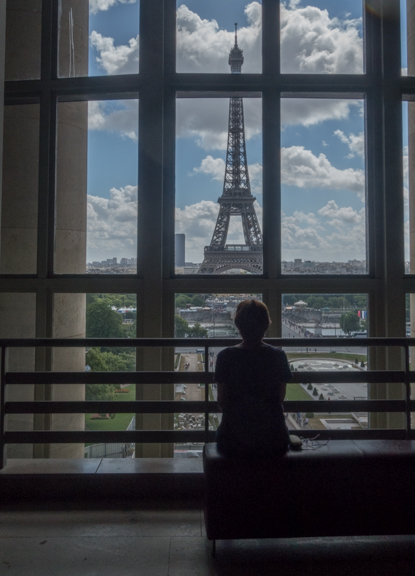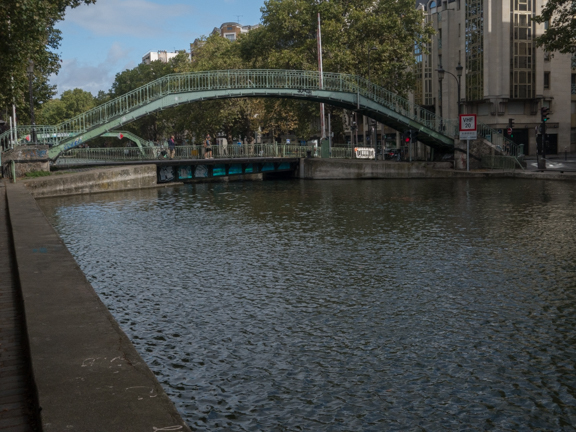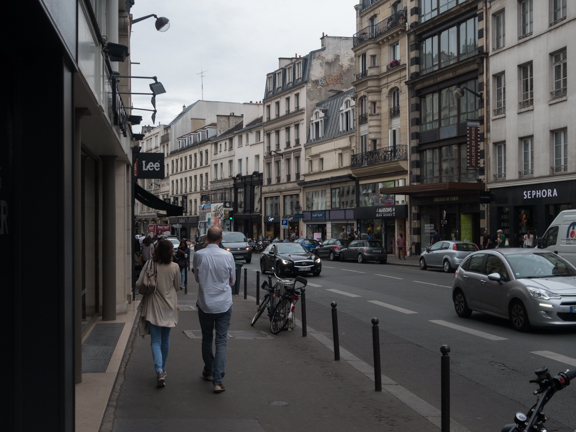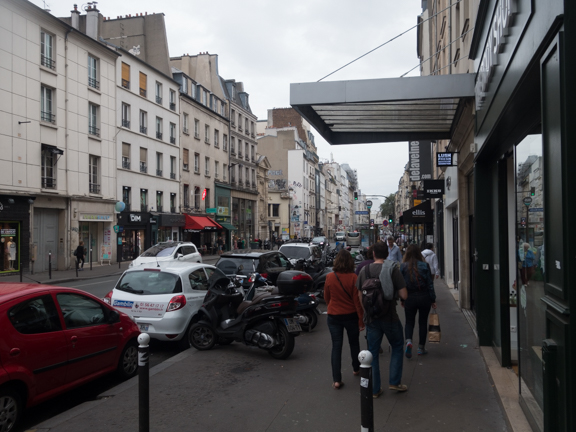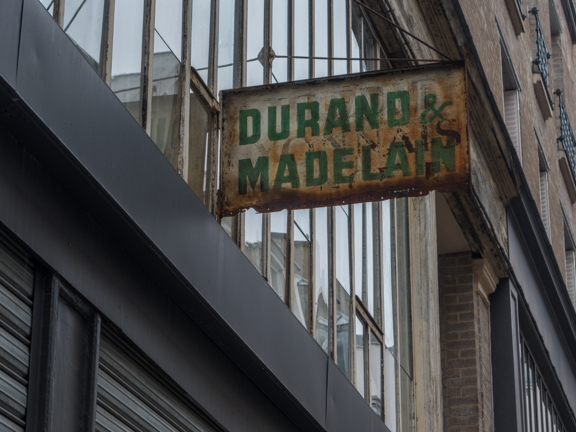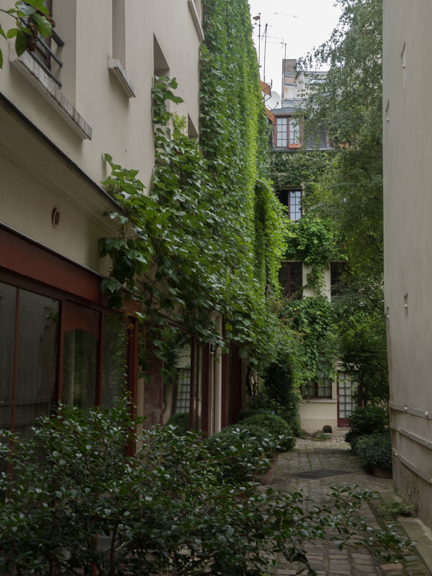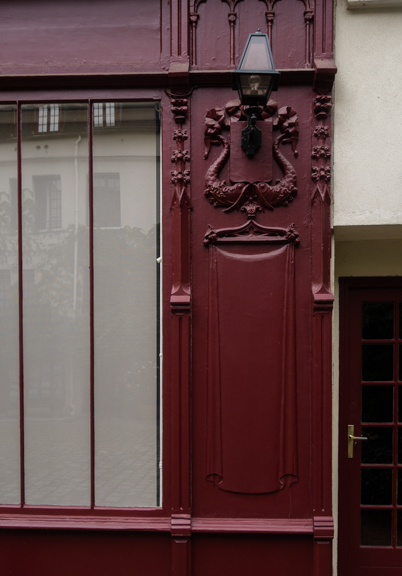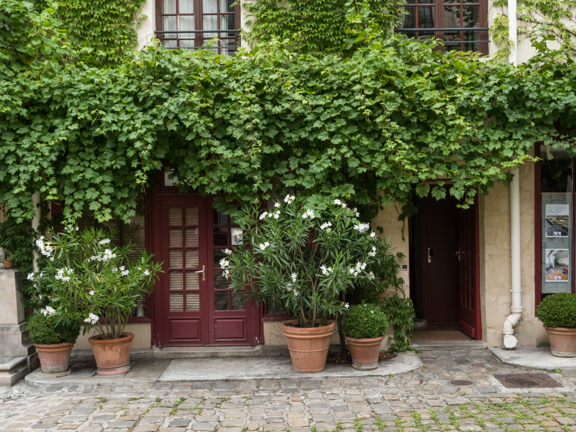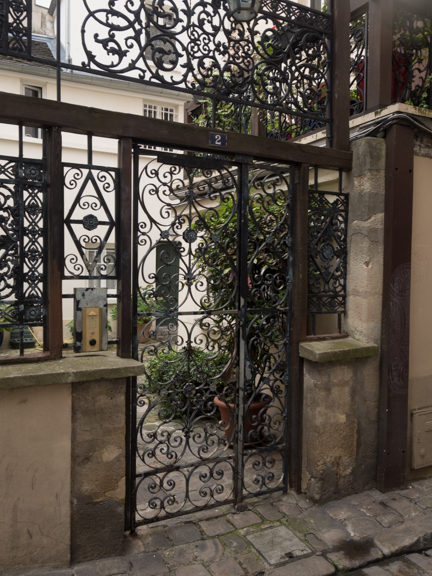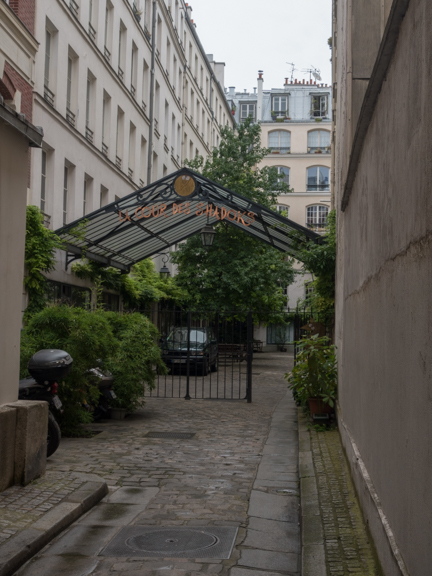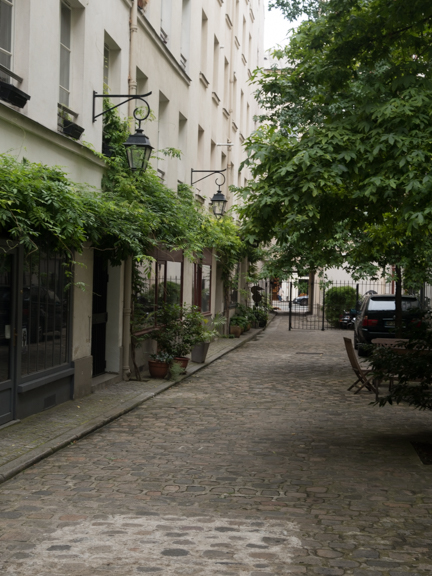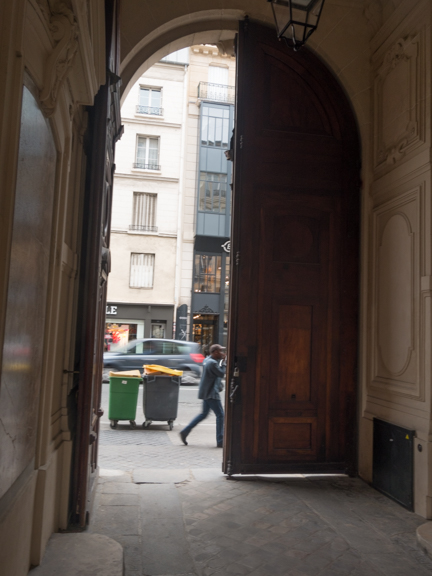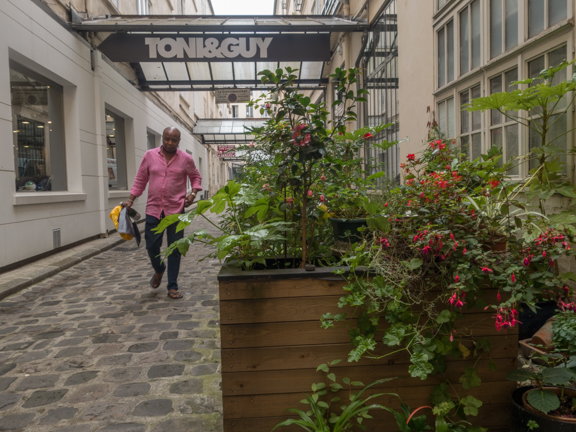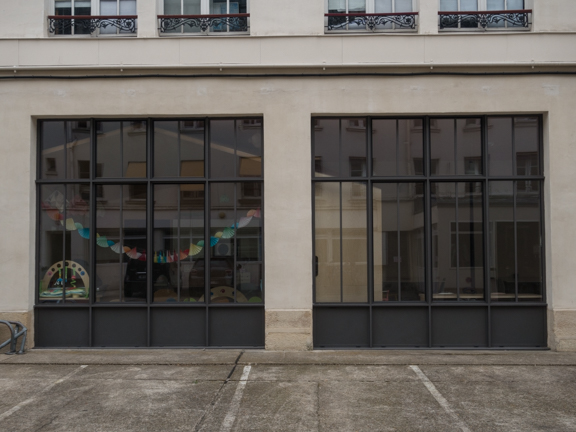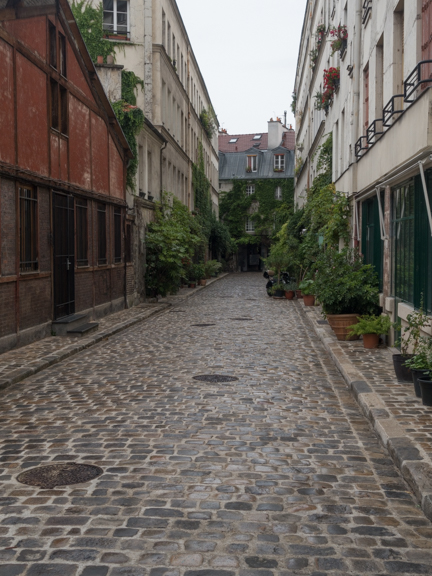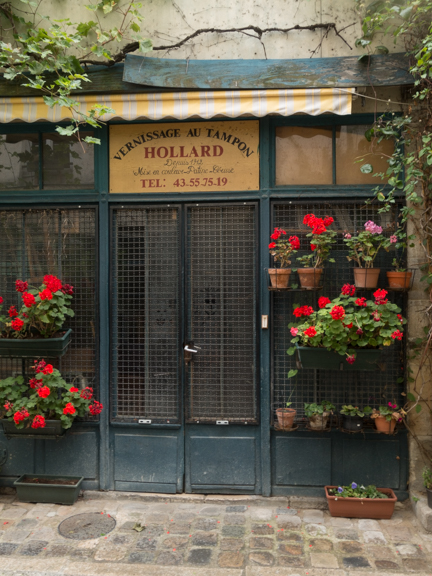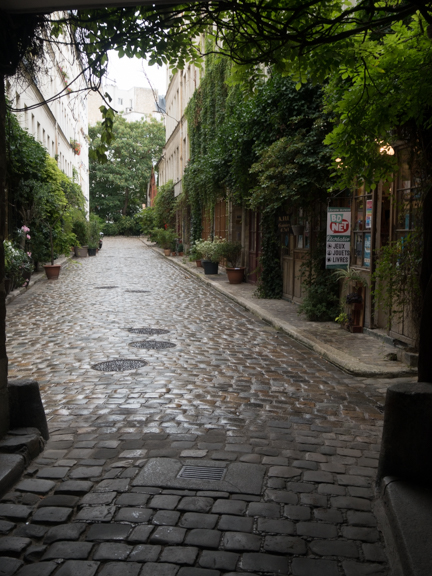We spent three days in Toulouse with Mary and Gilles. Toulouse is a big city, home to Airbus (a tour guide asked us where we all were from and when Laurie and I said, “Seattle,” her immediate response was, “Oh…Boeing”). Lots of interesting things to see, a river to walk by, a canal in the middle of town, and many beautiful buildings. Toulouse is known as the “Rose City” for it’s buildings of reddish-pink brick. We enjoyed Toulouse. I’m not going to write a lot about it; just show some pictures.
Toulouse has a serious market!
Some random Toulousienne buildings.
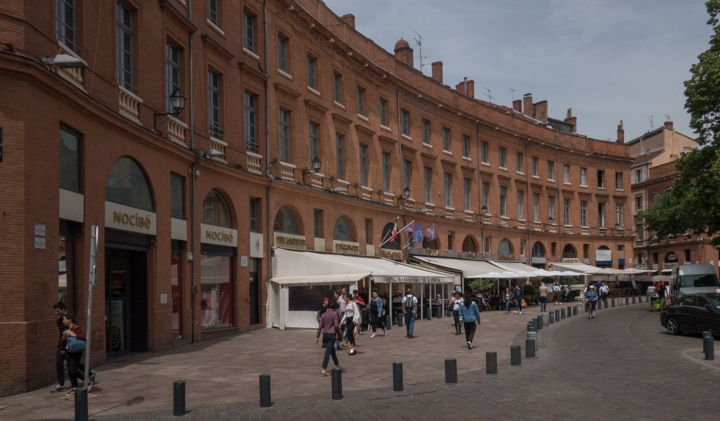 |
|||
Bastides
In previous years I’ve posted a couple times about bastide towns and, since we visited a few this trip, I’ll combine them into one post. A little background on these interesting towns:
In 1337 the king of France died without a direct heir to assume the throne. Shortly after, the English and the French started arguing about who should be the next king of France. Because the English monarchy actually descended from a French royal family, the English, who still controlled large parts of southwestern France, thought their claim to the French throne was better than anyone in the French royal family. The French politely disagreed and the two sides fell to fighting. For the next 116 years they fought, in three periods of war with not much happening in between, until the French gained the upper hand and threw the English out of France finally.
During much of the Hundred Years War (which should really be the Hundred-Sixteen Years War), the main fighting was done in the part of France we traveled through on this trip). During the wars, both sides built these bastide towns – more by the English – which had several characteristics:
- They were usually square, with straight roads in both directions to allow quick movement of troops from one side to another during a battle.
- They were fortified with walls and towers.
- They almost always had a main square, which contained a covered area for markets, and was surrounded by arcaded buildings.
With that background, here are a few bastide towns we visited.
Domme
An unusual aspect of Domme is that it is built on a hill and is definitely not square; most bastide towns were on flatter land. Because it is in the Dordogne region – a hugely popular tourist area – Domme has become a tourist attraction.

The Dordogne Valley from Domme. Can you imagine being in an attacking army below and looking up at Domme while your officers said, “Go get it!”
Domme was the site of some kind of “American Super-Car” gathering, as we saw 10 or 12 new Corvettes and these three Chrysler Vipers. I might point out that these Vipers, with their V10 engines, would require about somewhere around 60 cents of gas for every mile driven! I guess if you can afford a $70,000 car you can afford to drop five dollars just to get to the grocery store.
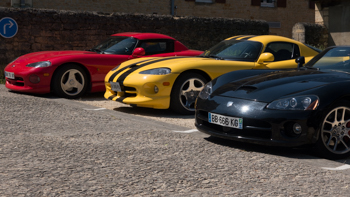
Like many popular tourist places, Domme has the tourist contrast:
Domme is not our favorite bastide, because it seems that its primary purpose is to extract money from tourists’ wallets.
Fources
Fources is an unusual bastide in that it is round. As with many towns of interest, it relies on tourist trade, as there is not much else to keep the town alive. Fources, though, is away from any strong tourist areas, so it has retained more of its small-town, historic feel. We liked Fources, and had a nice lunch here.
Lectoure
Ok, not a bastide, but Lectoure’s church has the best church sign we’ve ever seen:
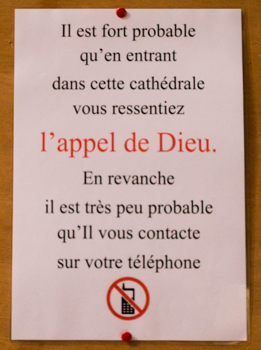
“It is highly likely that a person entering this church will sense the call of God. In return, it is much less probable that he will contact you on your phone. ” And a “turn it off” icon. Love it!
Cordes-sur-Ciel
Like Domme, Cordes is built on top of a hill, and like the other bastide towns, it relies on tourism for income, although there is quite a lot of farming in the area and I suspect some people in Cordes support that farming. However, Cordes’ main attraction for us was a startling church. The church has a beautiful and surprising interior; we just don’t see interiors like this, especially in small, rural towns.

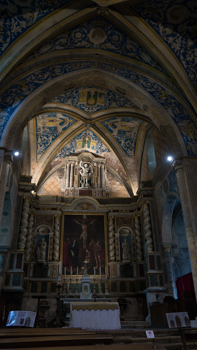
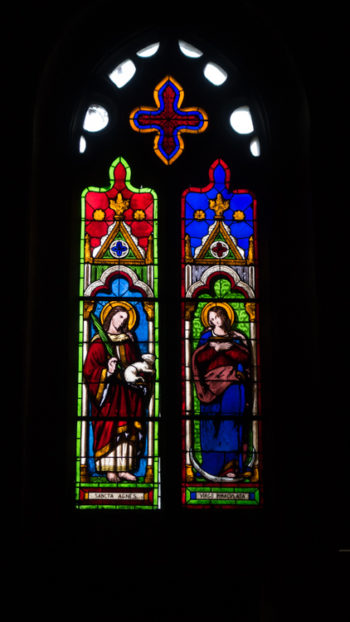
Some more Cordes pictures:
 |
|
One last comment about Cordes: the town has been known as Cordes for centuries. But in its search for the tourist trade, Cordes took advantage of its position high on a mountain-top to rename itself to a more appealing name, Cordes-sur-Ciel: Cordes in the Sky. Ah, marketing…
Vianne
One last bastide, Vianne. This is a real live active town, not relying at all on tourism. I stood in the middle of the main intersection and took pictures looking down each of the four main streets that meet there.
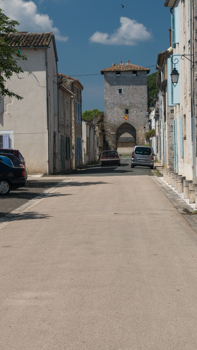 |
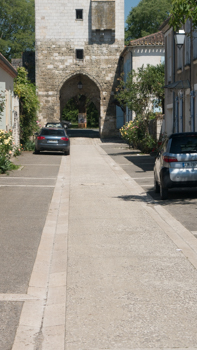 |
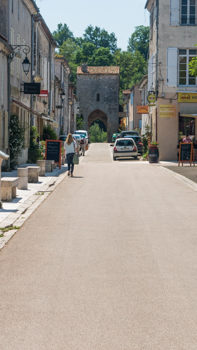 |
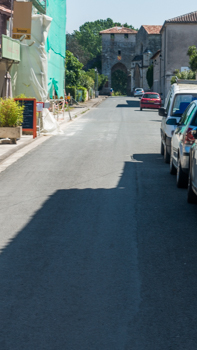 |
The four fortified towers that are the entrances to Vianne – typical of the bastides.
Vianne had one other sight that brought us here: a bridge designed and build by Gustave Eiffel, he of Eiffel Tower fame. It’s likely that his company designed and built it in the 1860s or 1870s, but official histories don’t mention this bridge by name. Still, a beautiful little bridge.
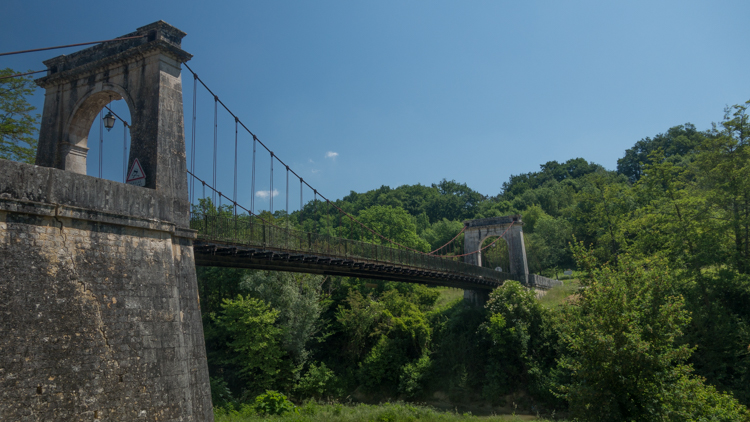
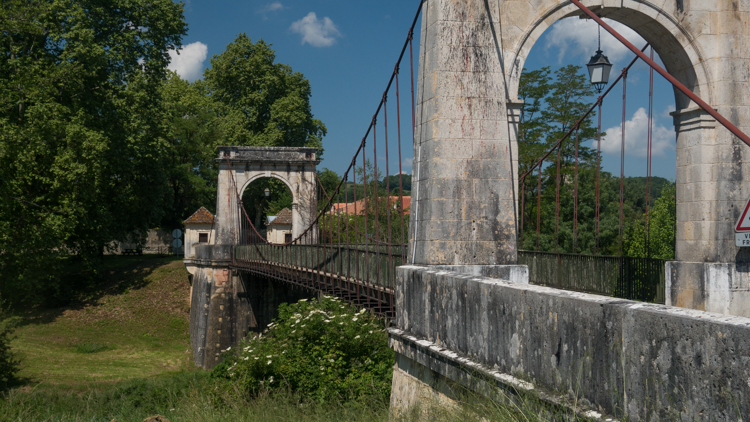
Okay, that’s enough for bastides. You’re probably as tired of reading about them as I am writing about them. I’ve left out our favorite bastide, Monpazier. We stopped there for lunch and a slow stroll through town. If you want to read about our favorite, click here: Monpazier, 2016
Gers – Part 2
Following up on the Gers – Part 1 post, here are some other places we visited in the Gers:
Lavardac
This small town a few miles from our base at Moulin de Bapaumes has one distinguishing feature: an amazing country market. It has everything: from live animals to mattresses (and even a car for sale). We’ve seen lots of markets and always find them interesting; this was a great one.
I call the car above dangerous because a driver does not need a license to drive it. There’s a whole class of cars here like that. They are limited to about 40 mph and are not to be driven on the autoroute (supposedly: I’ve seen one there, driving at 40 mph where the speed limit is 75.) Even around town, they’re a nuisance. The dangerous part is this: blind? You legally could drive one of these, since you don’t need a license. So the drivers of these cars are almost always folks who, for some reason, could not get a real driver’s license. That may hint at their driving abilities. I give these things a wide berth and my full attention when I see one on the road.
Barbaste
Barbaste is another small town, with just one sight to visit, but quite an interesting site. Here’s a picture of a small structure in Barbaste:
I know you’re all yawning and saying, “Oh, yeah, another fortress. Boring!” In fact, it is kind of a fort – in this case, a fortified mill. In the 1300s, when this mill was built, only the king or his representatives could mill wheat and so the power associated with that (local farmers were dependent on that mill) was closely guarded. Hence, the mill was fortified and stocked with soldiers to maintain that power. This mill was abandoned for hundreds of years, survived and is now being slowly restored.
Next to that mill are two kind of interesting sights. The first is a bridge built a hundred years so so before the mill, so, about a thousand years ago. It’s still in use.
And one last kind of funny thing. Across a street bordering the mill is a beautiful structure. Closer examination (and a hint from Danny and René at Moulin de Bapaumes) reveals it to be a “folie’; same as in English: a folly. This beautiful structure, which you’d expect to see as the façade on an impressive building, covers up…a staircase. Nothing else.
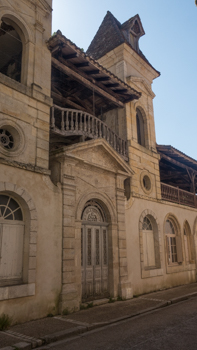 |
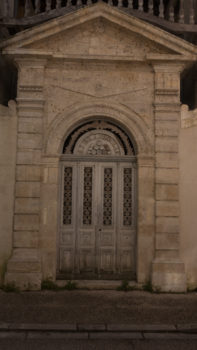 |
That’s it for today. More posts coming Real Soon Now.
Nérac and the Gers Region – Part 1
After our brief stay in Brive-la-Galliard, it was on to our destination, the Gers region. This region is in southwest France and although we visited just a small part on its northern edge, we enjoyed it greatly.
The impetus for this trip was mostly a book: “Duck Season” by David McAninch. Now I’m not generally a fan of the “American moves to a small town in a foreign country and learns the meaning of life” genre of books, but this one was great. The Gers is famous for the quantity and quality of the ways it serves duck and Mr. McAninch writes about the ways that ducks pervade life in the Gers: hunting ducks, raising ducks, cooking ducks, eating ducks, stuffing ducks to get foie gras, etc., etc. It all sounded interesting, so off we went with Mary & Gilles, our ever-patient friends.
Our base here was just outside the town of Nérac. From there we visited local towns but, oddly enough, had no duck – that had to wait until we visited Toulouse. But this area is beautiful, with lots of interesting things to see, and we’re glad we visited.
Moulin de Bapaumes
Our home in this beautiful area was a B & B named “Moulin de Bapaumes.” Now, I have not always been a fan of B&Bs, but we hit the jackpot with Moulin de Bapaumes; it sets the standard for what a B&B should be. Run by Danny and René, it has beautiful rooms and a beautiful setting. These two gentlemen know everything about the area and so offered recommendations on places to go, things to see, restaurants to try, and every recommendation was spot on. Honestly, I can’t praise them enough, but I can say that this previously B&B-phobe will be back to Moulin de Bapaumes in the years to come.
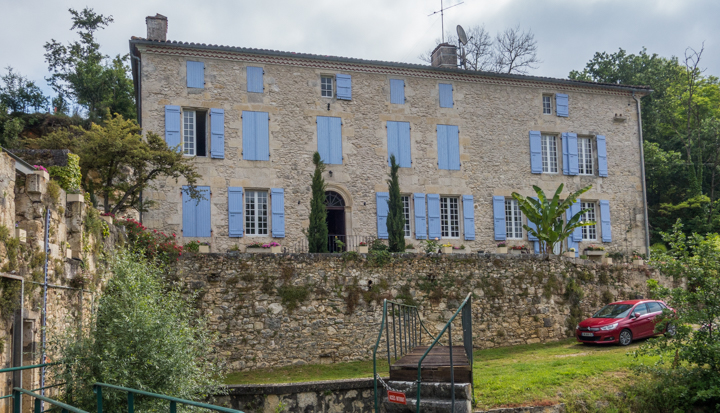 |
|
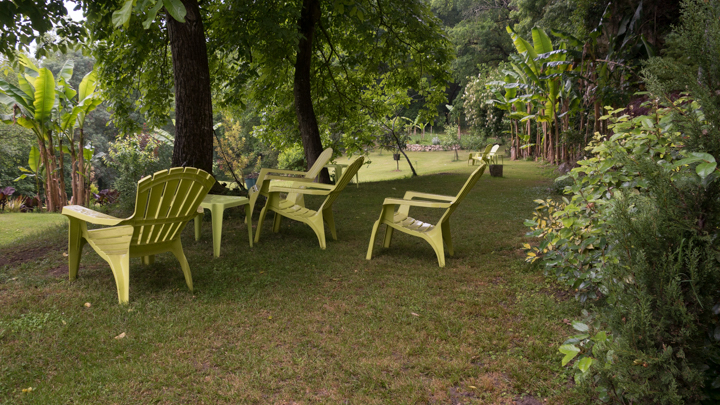 |
|
Now for some pictures of our rambles around Nérac…
Villenueve-Mezin
This town is tiny, with maybe ten houses. But it has one cool place to see, and one rather interesting house. The cool place to see:
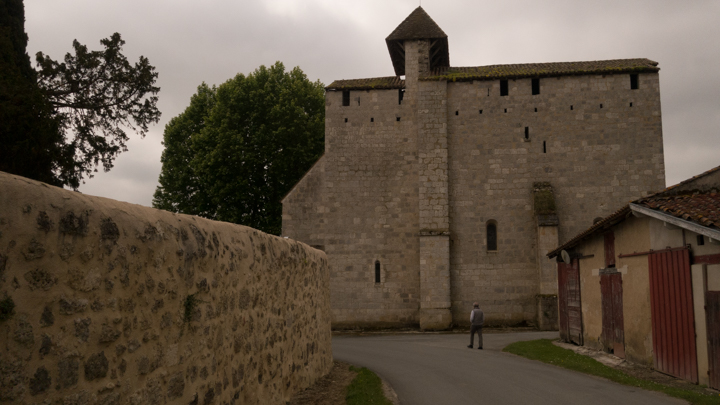
It’s a fortress, right? Built to defend the town and surrounding area, right? Yes and no. It was originally built to defend the area, but soon after its construction, the main interior area was turned into a church. This probably occurred about ten centuries ago. For many years it fell into disuse and disarry, but a German architect, Herman Schmitz, became interested in restoring this rare fortified church and spent many summers here leading the effort. Now, the interior looks like this:
The architect must love Villenueve-Mezin, as he also spent summers building a home here, on the remains of a small chateau. From the street, here is the home of him and his family:
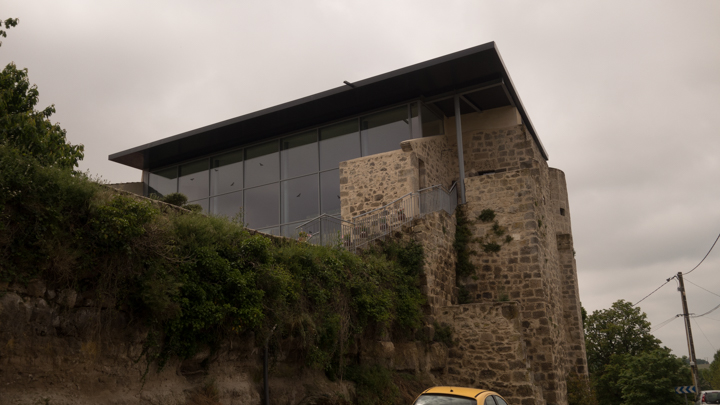
Not exactly a restoration! The building does retain original walls and some original windows, but it has been modernized completely. Honestly, it’s beautiful, and in this village, would be a place of complete calm and quiet. Here’s a view of the countryside from Villenue-Mezin.
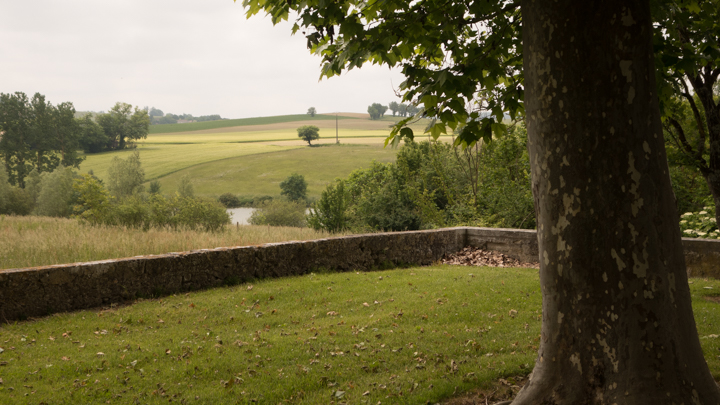
That’s a lot to write about such a small village, but this village has some special places; we’re glad we could make the trip to see it.
More on the area around Nérac, Real Soon Now.
Brieve-la-Galliard
First stop on our first ramble: Brive-la-Galliard, in the Dordogne region. We stayed a night here to break up the long drive to the southwest, and we were glad we did stop. An old town, Brive is working to make itself attractive to folks, rather than just letting the town fade away. The first step seems to have been a common one: get cars out of the historic area. As a result, it’s easy to stroll around the beautiful buildings of the downtown area, and so that’s what we did.
I’m not sure we’d make a special trip to Brive, but it was a nice overnight stay. Brive represents lots of French towns, with beautiful buildings and excellent restaurants; a great place to just walk around and absorb Frenchness!
Next stop: the Gers region, specifically the area around Nérac.
We Made it!
We made it to France – two weeks ago, actually – but not without a wee bit of drama at JFK in New York. We arrived at the airport plenty early (gotta love Lyft: cheaper, faster and way more comfortable than a shuttle), checked in, got through security (the TSA Pre-check line taking maybe twice as long as the regular line; go figure) and went to the gate. Our plane is there, everything looks good except that really dark, ugly cloud approaching the airport. Oh, did things get nasty. Rain and wind and lightning and thunder all around us; JFK actually closed for over an hour, and for a few minutes we could not see the runways about a quarter of a mile away because the rain was coming down so hard. We later learned that much of nearby Westchester County was without power for hours. We watched as the storm blew out to sea heading northeast.
Hmmm…northeast; that’s the direction we would be flying. Gulp. We boarded our plane (our favorite, the huge, double-deck Airbus A380) and after taxiing for 30 minutes, took off. Smooth, calm, no problem for about ten minutes, then ten minutes of pretty rough air. Now, when an A380 is getting tossed around, you can only imagine what those little commuter planes experienced. But we finally reached smooth air and the rest of the flight was nice. I found it interesting that because we flew so far north, there was light on the horizon the entire flight; it never got completely dark.
We arrived, picked up our car (a Renault Clio for the fourth time but this time a premium version, with leather seats and other fancy gadgets) and headed to the house of our friends Mary and Gilles. They welcomed us with open arms (and cheese). I can’t tell you how glad we were to be back in France!
After a few days at Mary & Gilles’ to recover from jet-lag we headed off on our first ramble, to the southwest of France: the Gers region, Toulouse, Albi and Clermont-Ferrand, Gilles’ home town. I’ll start a report on that trip tomorrow… stay tuned!
Grandkids!
Everyone who knows us knows these long trips are really just disguise for our very favorite activity: squeezing our grandkids! We went to Elmsford, NY first to refresh our grandkid-squeezing skills. We had just the best time with Craig and Annie and Clara and Henry. So, to get this 2018 version of our travel blog off to the right start, here are a few pictures.
Back in France, 2018
Yep, we’re in France again. In fact, we’ve been here almost two weeks, having arrived Wednesday, May 16. That means that, yes, I’m way behind posting to this world-famous – well, regionally well-known – travel blog. I’ll use the excuse that I’ve been busy traveling; yeah, that’s my story and I’m sticking to it.
First, our itinerary for this summer:
May 8: we left Seattle for New York.
May 9 – 15: serious grandchild-squeezing with Craig and Annie and Clara and Henry in New York. Pictures to follow, of course.
May 15: off to France. An uneventful flight after sitting at JFK airport and watching a horrendous storm pass over the airport, so bad that the airport closed for about an hour.
May 20: Off on a ramble to the Southwest of France. Pictures to follow.
May 20 – August 21: Hang around France, eat some cheese, drink some wine, see some sights, Pictures to follow.
August 21: Off to Spain for three weeks. We’ll drive from our home base in Bois-le-Roi/Samois-sur-Seine, visiting places we’ve been been to before: Zamora, Trujillo, Vejer-de-la-Frontera, Ùbeda and Segovia. Kind of a “greatest hits” tour, as these are our favorite small towns in Spain.
September 13: back to New York.
September 19: back to Seattle.
Should be fun…I hope you’ll follow along with us.
Chartres
Believe it or not, this is likely my last France post for this year. We’re now in New York (grandkid pictures to follow), having left France last Saturday. Flight over was no problem, except a little late, shuttle was waiting for us, so here we are in Elmsford.
Chartres
For years – literally – we have been saying that we needed to go to the town of Chartres to see its famous cathedral. Last Thursday, we had one last free day and when Mary suggested a day-trip somewhere, I suggested Chartres, and off we went.
Casa Picassiette
Mary said we definitely should see Casa Picassiette before we went to the Cathedral, so we did. Casa Picassiette is, um, an “unusual” house. The man who lived in it covered darn near every surface with mosaic designs made from broken plates he picked up during the day. Only a few pictures will describe this; words fail me.
But it gets better: some interior photos:
The man who built this was truly an artist.
Remember: everything was made from bits and pieces of broken plates over a period of more than 35 years. The man who created it worked at different jobs during the day and at his creation during the night. I might add, just as a sidelight, that he had several stays in a mental hospital. Just saying…
Chartres Cathedral
Most people who know these things say that the Cathedral at Chartres is the most beautiful Gothic cathedral in France and maybe the world. One reason is that it is far more original than other cathedrals; while there have been modifications, Chartres Cathedral is largely as it was when completed in the 13th century. Also, the cathedral was completed fairly quickly, meaning that its design is consistent throughout, with few hodge-podge additions tacked on at later dates.
In 2009 a major restoration started. Now, a key question in any restoration of this sort is, “To what period do you restore?” This restoration is being done to what was known of the Cathedral in in 1300s, when it was largely complete and fairly new. There are, of course, arguments among architectural historians about the restoration, but generally it seems to have been well-received. One interesting aspect is that, as the restorers cleaned walls, they discovered that in the 1300s the Cathedral interior was painted with a cream color, and so the restoration has used that color. It is just beautiful.
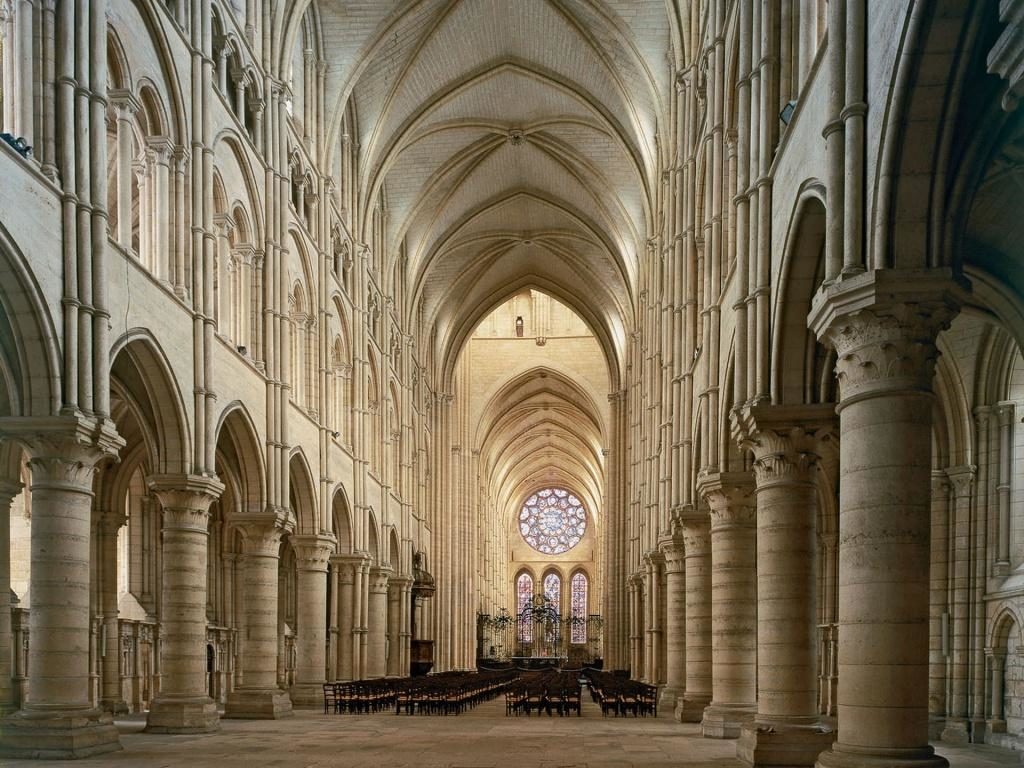
I cheated – this picture is swiped off the Internet. The lack of people gives away that I didn’t take it, but honestly, the Cathedral was not at all packed with people, as we had expected.
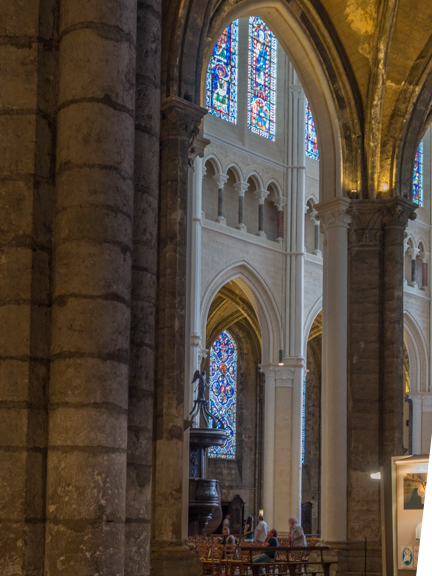
A wall, showing the beautiful cream color to which the interior is being restored after cleaning and repair.
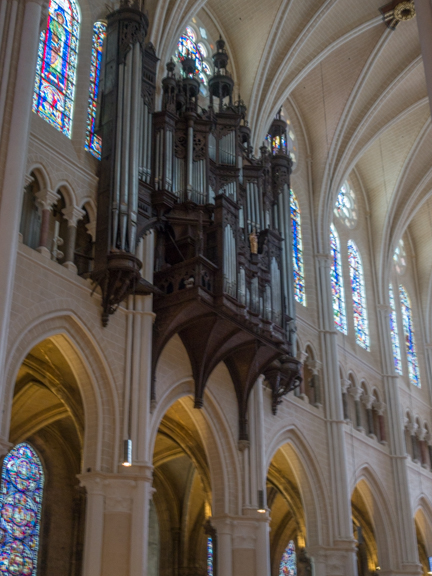
The organ, for Margaret. We listened to it being played for a while. Honestly, though organs in these huge cathedrals are powerful, the acoustics are terrible, and they often sound muddy.
The Cathedral definitely dominates the skyline in Chartres.
Because the Cathedral sits on the highest point of the city, if you approach from the south, you can see the Cathedral towering on the horizon long before you see the city itself.
One last beautiful part of the Chartres Cathedral: because it has escaped damage and changes over the centuries, its stained glass windows are largely intact. The creators of these windows used a special technique to create blue from cobalt, and the result is that these windows are works of art, with spectacular blues in them.
The city of Chartres looks to be interesting, and deserves a couple days, we think. We will be back, and we are so glad that we used our last day-trip to see the Cathedral.
Paris Visit
We went into Paris for a couple days last week. After watching the weather for a few days we realized we had a choice: Paris cool and with a chance of rain, or Paris hot. The forecast was right: this week in Paris (and here in Bois-le-Rois) has been hot, hot, hot – in the mid-90s. Now Paris in the rain isn’t great, but Paris in the mid-90s is undoable for us. So off we went Friday.
As a follow-up to my “La France est Compliquée” posts, here’s another example. We have Navigo passes which can be recharged for a week ($23) and which provide unlimited use of the trains (which we ride to and from Paris), metros, buses (which we much prefer) and trams for that week. On Friday we arrived at the train station and I asked to recharge our Navigo passes for this week. Nope, can’t do it. After Thursday, I can only recharge them for next week, which means that we can’t use them for our trip, which starts on Friday. Now, if someone has a good explanation as to why we can’t recharge a weekly pass after Thursday, I’d love to hear it. Anyway, we bought train tickets and when we arrived in Paris, metro tickets (also good on buses and trams). Compliquée…
Cité de la Architecture et Patrimoine.
This is likely our favorite museum in Paris. We returned – the fifth time we’ve been there – and still didn’t see all we wanted to see. One floor of the museum is dedicated to models of buildings, with explanations showing the history of French architecture (in French, of course; between Laurie and I we can muddle through and understand. Mostly). Here is part of this floor:
The museum has a fair amount about le Corbusier, about whom I’ve posted (le Corbusier). Here there is a unit from an apartment building in Marseille that he designed. We spent probably half an hour in it, and Laurie’s favorite thing was:
The view is not bad from this museum…
This museum is worth a visit, for sure. In fact, we decided that when we return to France, we’ll just buy a couple annual passes to it. I’ve posted about Cité in past years; if I can find the posts I’ll add a link here.
Canal St. Martin
This is probably our favorite walk in Paris, rain or shine (and it ended with rain this time). Canal St. Martin was build by Emperor Napoleon to bring water to Paris, to ease transportation by boats of goods into the city and, maybe most importantly, to put a physical barrier between Paris and the Saint Antoine quarter, a powerful working class area from which revolutions arose. In the 1960s, as the need for the canal declined, there was talk of filling it and doing something with this most valuable land. Wiser heads prevailed, and the canal has remained, a beautiful path through the city.
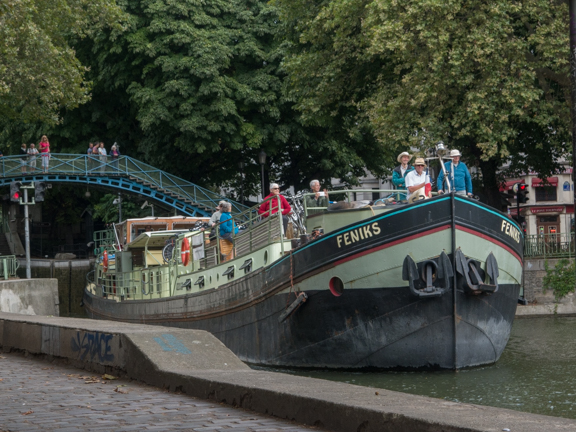
Boats still travel on Canal St. Martin, but they are tour boats or tourist barges; it’s been a long time since we saw a commercial boat on Canal St. Martin.
Rue du Faubourg-Saint-Antoine
For years I’ve gotten a big kick out of Rue du Faubourg-Saint-Antoine. This is a big, crazy, busy, noisy, working street, and it fascinates me; I love to walk it. A couple trips ago I learned that there are many courtyards and passages off Rue du Faubourg-Saint-Antoine, so I went looking for them, and I found a bunch. On this, our last trip to Paris this year, Laurie wanted to see these, and so off we went. I’ll just post pictures of them with captions where appropriate.
First, a couple pictures of Rue du Faubourg-Saint-Antoine. Actually, it seems a little calm here, on a Saturday morning, but you can see that it’s a busy street.
Now for a look at the passages and courtyards that are connected to Rue du Faubourg-Saint-Antoine. None of these are visible from the street; you have to just walk down the street and when you see a big double door, see if it’s open. I have no qualms about going into the ones with closed doors. In fact, several of these were behind a closed locked door, in which case we stood outside until someone with the passcode to the door came in or left, and then we entered before the door could close. No one ever said a word to us about why were were there.
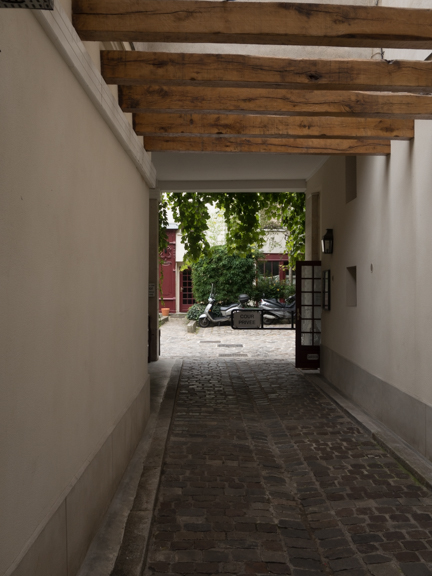
Cour Bel Air, probably the prettiest courtyard on Rue du Faubourg-Saint-Antoine. Here there’s a big sign blocking entry, so we asked the concierge if we could go in and look around. Pas de problème. She was as nice as could be.
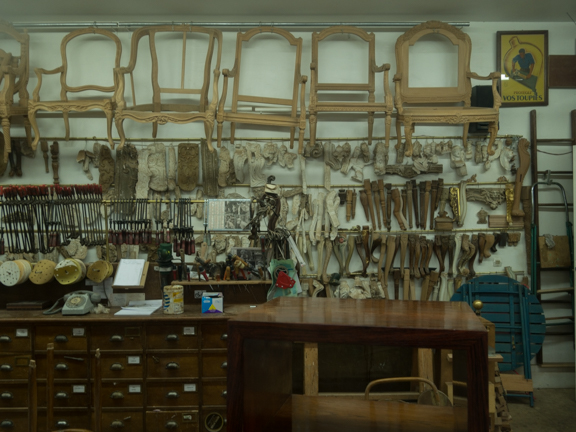
Many of the courtyards and passages have connections to housing and decoration trades, a vestige of when this quartier was the home for those trades. This is a place that restores and repairs chairs. We looked in the windows, and it was amazing.
One last detour, to Passage l’Homme, around the corner from Rue du Fauborg-Saint-Antoine. This is also a beautiful place, pretty much unknown.
It rained off and on during this walk, and finally it started to rain enough that we called it quits. I know that few tourists will ever have the time or inclination to search out the Rue du Faubourg-Saint-Antoine passages, especially after seeing the rue itself, with its noise and traffic and craziness. So I hope this post gives you a sense of a different Paris, the seldom-seen-by-tourists Paris. I still think this is one of the coolest streets in Paris.

